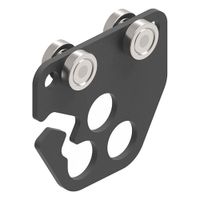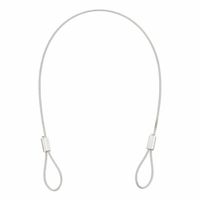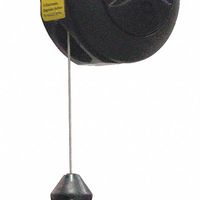Call +(254) 703 030 000 / 751 483 999 / 721 704 777
.....Read More
Frequently Asked Questions
What are tool balancers and how do they work?
Tool balancers are devices designed to support and manage the weight of hand tools, making them easier to handle and reducing operator fatigue. They are commonly used in industrial and manufacturing settings where repetitive tool use is required. Tool balancers consist of a retractable cable or wire that is attached to a spring mechanism housed within a casing. The tool is connected to the end of the cable, allowing it to be suspended above the work area.
The primary function of a tool balancer is to counterbalance the weight of the tool, effectively making it "weightless" in the hands of the operator. This is achieved through the tension in the spring mechanism, which is adjustable to accommodate different tool weights. When the tool is pulled down for use, the spring extends, and when released, the spring retracts, pulling the tool back to its original position. This not only reduces the physical strain on the user but also helps in maintaining a tidy and organized workspace by keeping tools off the workbench when not in use.
Tool balancers come in various designs, including constant force, zero gravity, and retractable models, each suited for different applications and tool weights. They are particularly beneficial in assembly lines, automotive repair, and any environment where tools are frequently used and need to be readily accessible. By minimizing the effort required to handle tools, tool balancers enhance productivity, improve safety by reducing the risk of repetitive strain injuries, and extend the lifespan of tools by preventing accidental drops.
What are the benefits of using tool balancers and retractors in industrial settings?
Tool balancers and retractors offer several benefits in industrial settings, enhancing efficiency, safety, and ergonomics.
1. **Increased Productivity**: By keeping tools readily accessible and reducing the time spent searching for or retrieving them, tool balancers and retractors streamline workflow processes. This leads to faster task completion and improved overall productivity.
2. **Enhanced Safety**: These devices help prevent workplace accidents by minimizing the risk of tools being dropped or misplaced. Retractors ensure that tools are securely retracted when not in use, reducing tripping hazards and potential injuries.
3. **Ergonomic Benefits**: Tool balancers reduce the physical strain on workers by supporting the weight of heavy tools. This minimizes fatigue and the risk of repetitive strain injuries, contributing to a healthier work environment.
4. **Extended Tool Life**: By preventing tools from being dropped or mishandled, balancers and retractors help maintain tool integrity and extend their lifespan. This reduces the frequency of tool replacements and associated costs.
5. **Improved Organization**: These devices contribute to a more organized workspace by keeping tools in designated areas. This organization reduces clutter and enhances the efficiency of tool management.
6. **Cost Efficiency**: While there is an initial investment in tool balancers and retractors, the long-term savings from reduced tool damage, lower injury rates, and increased productivity make them cost-effective solutions.
7. **Versatility**: Tool balancers and retractors are adaptable to various tools and applications, making them suitable for diverse industrial environments. They can be used in assembly lines, workshops, and maintenance areas, among others.
Overall, the integration of tool balancers and retractors in industrial settings leads to a safer, more efficient, and cost-effective operation, benefiting both employers and employees.
How do I choose the right tool balancer for my application?
1. **Understand the Application Requirements**: Determine the weight and type of tool you need to balance. Consider the frequency of use and the environment in which it will be used.
2. **Weight Capacity**: Choose a tool balancer that can handle the weight of your tool. Balancers are rated for specific weight ranges, so ensure the tool's weight falls within this range.
3. **Stroke Length**: Consider the vertical movement required. The stroke length of the balancer should accommodate the full range of motion needed for the task.
4. **Type of Balancer**: Decide between a spring balancer or a zero-gravity balancer. Spring balancers are suitable for heavier tools, while zero-gravity balancers are ideal for lighter tools requiring precision.
5. **Mounting Options**: Ensure the balancer can be mounted in your workspace. Options include ceiling, wall, or bench mounting, depending on the layout and workflow.
6. **Durability and Material**: Choose a balancer made from durable materials, especially if used in harsh environments. Consider corrosion resistance if used in humid or chemical-prone areas.
7. **Adjustability**: Look for balancers with adjustable tension settings to fine-tune the balance according to the tool's weight and user preference.
8. **Safety Features**: Ensure the balancer has safety features like a safety chain or cable to prevent accidents if the main cable fails.
9. **Ergonomics**: Consider the ergonomic benefits, such as reducing operator fatigue and improving productivity.
10. **Cost and Brand Reputation**: Balance cost with quality. Opt for reputable brands known for reliability and customer support.
11. **Consultation and Testing**: If unsure, consult with manufacturers or suppliers for recommendations and, if possible, test the balancer in your application before purchasing.
What is the difference between a tool balancer and a tool retractor?
A tool balancer and a tool retractor are both devices used to manage tools in a workspace, but they serve different purposes and operate differently.
A tool balancer is designed to support the weight of a tool, making it easier for the user to handle. It typically consists of a spring mechanism housed in a casing, with a cable or cord attached to the tool. The balancer maintains the tool in a suspended position, counterbalancing its weight. This allows the user to move the tool with minimal effort, reducing fatigue and improving precision. Tool balancers are commonly used in assembly lines and workshops where tools are frequently used and need to be readily accessible.
On the other hand, a tool retractor is primarily used to retract a tool back to a specific position after use. It also uses a spring mechanism, but its main function is to pull the tool back to its original position, often for storage or safety purposes. Tool retractors are useful in environments where tools need to be kept out of the way when not in use, preventing clutter and potential hazards. They are often used in settings like garages or maintenance areas where space is limited.
In summary, while both devices use spring mechanisms, a tool balancer focuses on weight support and ease of use, whereas a tool retractor emphasizes tool retrieval and storage.
How do I maintain and care for tool balancers and retractors?
To maintain and care for tool balancers and retractors, follow these steps:
1. **Regular Inspection**: Frequently check for wear and tear, including frayed cables, damaged springs, and loose components. Ensure all parts are intact and functioning properly.
2. **Cleaning**: Keep the balancer and retractor clean by wiping them with a dry or slightly damp cloth. Avoid using harsh chemicals that could damage the materials.
3. **Lubrication**: Periodically lubricate moving parts, such as the spring and pivot points, with a suitable lubricant to ensure smooth operation and prevent rust.
4. **Tension Adjustment**: Regularly check and adjust the tension to match the weight of the tool being used. This ensures optimal performance and reduces strain on the device.
5. **Storage**: Store in a dry, clean environment when not in use. Avoid exposure to extreme temperatures and humidity, which can degrade materials over time.
6. **Load Capacity**: Always use the balancer and retractor within their specified load capacity to prevent damage and ensure safety.
7. **Cable Management**: Ensure cables are not twisted or kinked during use. This prevents premature wear and maintains smooth retraction.
8. **Replacement Parts**: Use only manufacturer-approved parts for replacements to maintain the integrity and safety of the device.
9. **Training**: Ensure all users are trained in the proper use and maintenance of tool balancers and retractors to prevent misuse and damage.
10. **Documentation**: Keep a maintenance log to track inspections, adjustments, and repairs. This helps in identifying patterns of wear and planning preventive maintenance.
By following these guidelines, you can extend the lifespan of your tool balancers and retractors, ensuring they remain safe and efficient for use.
What safety features should I look for in tool balancers and retractors?
When selecting tool balancers and retractors, prioritize the following safety features:
1. **Load Capacity**: Ensure the balancer matches the weight of the tool to prevent overloading, which can lead to failure.
2. **Locking Mechanism**: Look for a reliable locking mechanism to secure the tool in place when not in use, preventing accidental drops.
3. **Cable Quality**: Opt for high-strength, corrosion-resistant cables to withstand wear and tear, reducing the risk of snapping.
4. **Safety Chain or Strap**: A secondary safety chain or strap can prevent the tool from falling if the primary cable fails.
5. **Anti-Recoil Feature**: This prevents the tool from snapping back quickly if released suddenly, reducing the risk of injury.
6. **Ergonomic Design**: Ensure the balancer is ergonomically designed to reduce strain on the user, promoting safe and comfortable operation.
7. **Adjustable Tension**: The ability to adjust tension allows for precise control, ensuring the tool remains stable and easy to handle.
8. **Durable Housing**: Choose balancers with robust, impact-resistant housing to protect internal components from damage.
9. **Overload Protection**: Some balancers have built-in overload protection to prevent damage from excessive weight.
10. **Smooth Retraction**: A smooth retraction mechanism minimizes jerking motions, enhancing user safety.
11. **Visual Indicators**: Features like load indicators or tension gauges help monitor the balancer's status, ensuring it operates within safe limits.
12. **Compliance with Standards**: Ensure the balancer complies with relevant safety standards and regulations for added assurance.
13. **Regular Maintenance**: Opt for models that are easy to maintain and inspect, ensuring long-term safety and reliability.
By focusing on these features, you can enhance workplace safety and efficiency when using tool balancers and retractors.
Can tool balancers be used with both pneumatic and electric tools?
Yes, tool balancers can be used with both pneumatic and electric tools. Tool balancers are designed to support and manage the weight of various tools, making them easier to handle and reducing operator fatigue. They work by suspending the tool from a retractable cable, which can be adjusted to balance the tool's weight, allowing for smooth and effortless operation.
For pneumatic tools, tool balancers help manage the weight and the air hose, preventing tangling and reducing strain on the operator. This is particularly beneficial in environments where pneumatic tools are frequently used, as it enhances productivity and safety by keeping the workspace organized and reducing the risk of accidents.
Similarly, tool balancers are compatible with electric tools. They help manage the weight of the tool and the power cord, preventing cord damage and reducing the risk of tripping hazards. This is especially useful in assembly lines or workshops where electric tools are used continuously, as it ensures a more efficient workflow and prolongs the lifespan of the tools by minimizing wear and tear.
In both cases, tool balancers contribute to ergonomic benefits by reducing the physical strain on workers, which can lead to fewer work-related injuries and increased efficiency. They are available in various sizes and capacities to accommodate different tool weights and types, making them versatile for a wide range of applications.
How do I install and set up a tool balancer or retractor?
To install and set up a tool balancer or retractor, follow these steps:
1. **Select Location**: Choose a suitable location above the work area where the tool will be used. Ensure it is strong enough to support the weight of the tool and the balancer.
2. **Mounting**: Use a secure mounting point such as a beam, ceiling, or a dedicated support structure. Attach the balancer using a hook, bracket, or other mounting hardware provided by the manufacturer. Ensure it is tightly secured to prevent movement.
3. **Adjust Cable Length**: Pull out the cable to the desired length. Most balancers have a locking mechanism to hold the cable at a specific length. Adjust it so the tool is within easy reach but not so long that it drags on the work surface.
4. **Attach Tool**: Connect the tool to the end of the balancer cable. Use the appropriate attachment method, such as a hook or a carabiner, ensuring it is securely fastened.
5. **Tension Adjustment**: Adjust the tension of the balancer to match the weight of the tool. This is usually done by turning a tension adjustment knob or screw. The tool should remain suspended without drifting up or down when not in use.
6. **Test Operation**: Pull the tool down to ensure smooth operation and that it retracts properly. Make sure the tool can be easily moved to the work area and returns to its resting position without excessive force.
7. **Safety Check**: Inspect all connections and the mounting point to ensure everything is secure. Check for any signs of wear or damage on the cable and housing.
8. **Regular Maintenance**: Periodically check the balancer for wear and tear, and adjust the tension as needed to maintain optimal performance.
What accessories are available for tool balancers and retractors?
Accessories for tool balancers and retractors enhance their functionality and adaptability in various industrial settings. Common accessories include:
1. **Mounting Brackets**: These allow for secure attachment of the balancer or retractor to workstations, ceilings, or walls, providing flexibility in positioning.
2. **Safety Cables**: These are used to prevent the tool or balancer from falling in case of a failure, ensuring workplace safety.
3. **Hooks and Clips**: Different types of hooks and clips can be attached to the end of the balancer cable to accommodate various tools and equipment.
4. **Cable Stops**: These are used to limit the retraction length of the cable, preventing the tool from retracting too far and causing damage.
5. **Swivel Assemblies**: These allow for 360-degree rotation of the tool, reducing cable wear and enhancing maneuverability.
6. **Trolleys**: Used for overhead rail systems, trolleys enable the balancer to move along a track, providing greater range of motion.
7. **Tool Holders**: Customizable holders or cradles can be attached to secure specific tools, ensuring they are held firmly in place.
8. **Balancing Springs**: Additional or replacement springs can be used to adjust the tension and balance of the tool, accommodating different weights.
9. **Protective Covers**: These protect the balancer or retractor from dust, debris, and other environmental factors, extending their lifespan.
10. **Extension Arms**: These provide additional reach and flexibility, allowing tools to be used in a wider area without repositioning the balancer.
11. **Load Indicators**: These provide visual feedback on the load being supported, ensuring the balancer is not overloaded.
These accessories help customize tool balancers and retractors to specific applications, improving efficiency and safety in the workplace.
How do tool balancers and retractors help reduce workplace injuries?
Tool balancers and retractors play a crucial role in reducing workplace injuries by enhancing ergonomics, minimizing physical strain, and improving safety. These devices are designed to support and manage the weight of tools, making them easier to handle and reducing the risk of musculoskeletal disorders (MSDs) among workers.
Firstly, tool balancers help maintain tools in a suspended state, allowing workers to use them with minimal effort. This reduces the need for workers to bear the full weight of the tool, thereby decreasing the strain on their muscles and joints. By alleviating the physical burden, tool balancers help prevent repetitive strain injuries, which are common in environments where tools are used frequently and for extended periods.
Secondly, retractors ensure that tools are automatically retracted to a safe position when not in use. This reduces the risk of tripping hazards and accidental injuries caused by tools being left in unsafe positions. Retractors also help in maintaining an organized workspace, which is essential for preventing slips, trips, and falls.
Moreover, both tool balancers and retractors contribute to improved posture by allowing workers to maintain a more natural and comfortable position while using tools. This ergonomic benefit is significant in preventing back injuries and other posture-related issues.
Additionally, these devices can enhance productivity by reducing fatigue. When workers are less fatigued, they are more alert and less prone to making mistakes that could lead to accidents or injuries. This not only improves safety but also boosts overall efficiency and job satisfaction.
In summary, tool balancers and retractors are vital in promoting a safer work environment by reducing physical strain, preventing accidents, and supporting ergonomic practices, ultimately leading to fewer workplace injuries.


